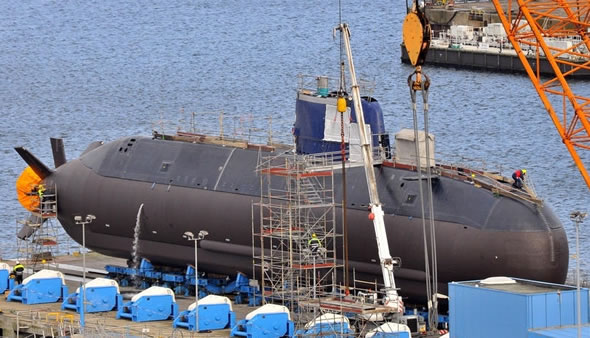Following successful builder’s sea trials the Howaldtswerke-Deutsche Werft (HDW) shipyard in Kiel delivered today the forth Dolphin class submarine, designated INS “Tanin” to the Israel Navy. The 68 meter long ‘Super Dolphin’ submarine is believed to be the largest produced in Germany since World War II. With further sea trials commencing this year, INS Tanin is due to arrive in Israel in 2013 with the sister ship Rahav scheduled to join the Israel Navy in 2014.

In 2006 the Israel Navy has embarked on a strategic increase of its submarine force, doubling the number of submarines and significantly extending mission range and endurance. Apart their conventional anti-ship armament that includes torpedos, according to foreign sources, Israel’s Dolphin submarines are equipped with land-attack or cruise missiles capable of carrying nuclear tactical warheads. These allegedly strategic assets provide this small sized country with ‘second strike’ capability that should deter possible hostile action by opponents tempted to ‘finish it with one blow’. As the strategic balance has changed since the early 2000s, with countries like Iran building an unconventional, nuclear threat, Israel would need to maintain submarines on longer patrols at sea, keeping all potential targets within reach at all times. Hence the need for more submarines.

Last month Defense Minister Ehud Barak was in Germany to sign the contract for the sixth Dolphin submarine, to be delivered in 2017. According to Ehud Barak, Israel considers the new submarines as a powerful force multiplier adding to the already impressive fighting capabilities of the IDF, facing the constantly growing regional challenges. The Navy has been undergoing a number of strategic changes in recent years; changes that place it as the strategic long arm of the IDF, at the very forefront of the campaign to secure the State of Israel.

Submarines are strategic platforms allowing the navy to operate in the Mediterranean, as well as in any other region where its presence is required. The Israel Navy currently operates three Dolphin class subs – Dolphin, Leviathan and Tekuma. They are believed to be some of the most advanced diesel-electric submarines in the world. The new Dolphins are dubbed ‘Super Dolphin’, being equipped with the new Air Independent Propulsion (AIP) system, a fuel cell supporting the electrical propulsion and supply system and provides life- support without the need to surface or ascend to ‘snorkel’ level, thus providing more survivable and stealthier missions, operating submerged over several weeks, without surfacing. Until the introduction of AIP such capabilities were only available to nuclear powered submarines. The Israel Navy opted to integrate AIP in all its three ordered Super Dolphins, while the currently operational Dolphin submarines could be converted into AIP-supported versions, through their future mid-life upgrade.
As the prime contractor HDW was responsible for development, construction and integration of all Dolphin class submarines and the advanced combat systems with which the vessel is equipped. The acquisition of the three submarines is estimated to cost about US$1.5 billion, with a third of the cost covered by German Government assistance. The Israel Navy commander, Admiral Ram Rothberg noted this important support “at a time when threats are becoming global in their nature, the relationship between Israel and Germany is more critical than ever.” The Director General of the Ministry of Defense, retired Major General Udi Shani lauded the German Government assistance and contribution to the strengthening of Israel’s submarine force. “The ceremony, more than anything, symbolizes the strong and unique bond between Germany and Israel”.
The submarine named INS Tanin, is the third submarine carrying this name to serve in the Israel Navy. The first INS Tanin designated Z-71 (or S-71) was one of two ex-Royal Navy S- class submarine, commissioned in 1945, which served in the Israel Navy between 1959 to 1968. The second Tanin was also built in the UK, based on the German Type 206 (Gal) design; it entered service in 1977 and was decommissioned in 2002.

















